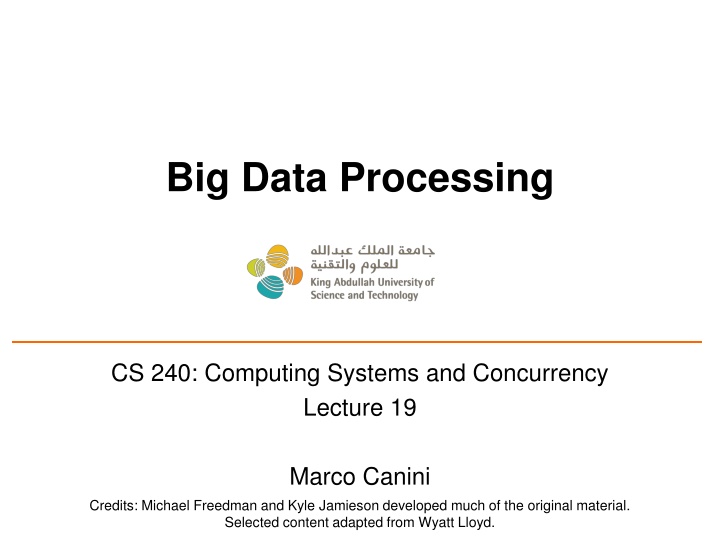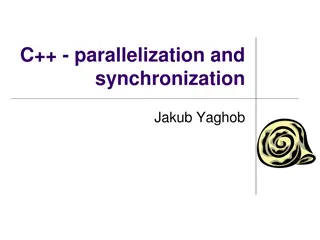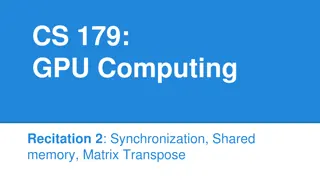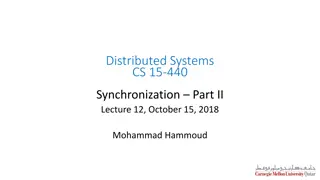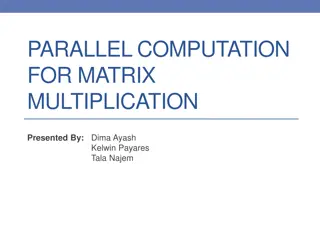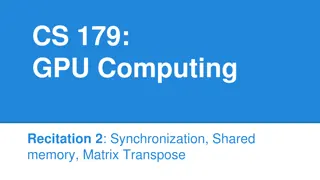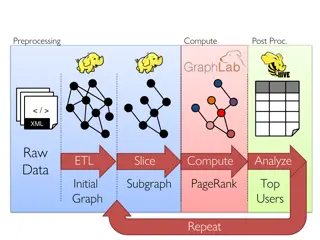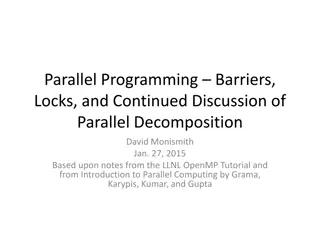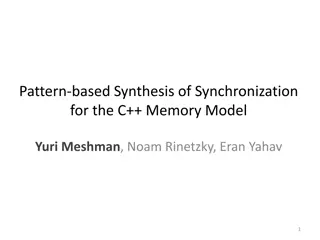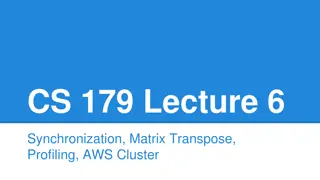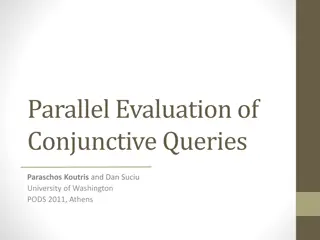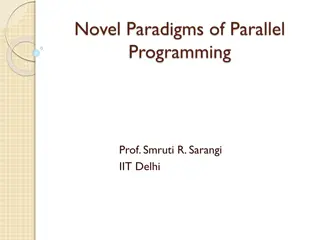Data-Parallel Computation and Synchronization Techniques
This content delves into data-parallel computation, fault tolerance in MapReduce, generality versus specialization in computing systems, and the efficiency of systems like MapReduce for large-scale computations. It covers techniques such as synchronization barriers, map-combine-partition-reduce processes, and the balance between general systems and specialized applications.
Download Presentation

Please find below an Image/Link to download the presentation.
The content on the website is provided AS IS for your information and personal use only. It may not be sold, licensed, or shared on other websites without obtaining consent from the author.If you encounter any issues during the download, it is possible that the publisher has removed the file from their server.
You are allowed to download the files provided on this website for personal or commercial use, subject to the condition that they are used lawfully. All files are the property of their respective owners.
The content on the website is provided AS IS for your information and personal use only. It may not be sold, licensed, or shared on other websites without obtaining consent from the author.
E N D
Presentation Transcript
Big Data Processing CS 240: Computing Systems and Concurrency Lecture 19 Marco Canini Credits: Michael Freedman and Kyle Jamieson developed much of the original material. Selected content adapted from Wyatt Lloyd.
Ex: Word count using partial aggregation 1. Compute word counts from individual files 2. Then merge intermediate output 3. Compute word count on merged outputs 3
Putting it together map combine partition ( shuffle ) reduce 4
Synchronization Barrier 5
Fault Tolerance in MapReduce Map worker writes intermediate output to local disk, separated by partitioning. Once completed, tells master node Reduce worker told of location of map task outputs, pulls their partition s data from each mapper, execute function across data Note: All-to-all shuffle b/w mappers and reducers Written to disk ( materialized ) b/w each stage 6
General Systems Can be used for many different applications Jack of all trades, master of none Pay a generality penalty Once a specific application, or class of applications becomes sufficiently important, time to build specialized systems 8
MapReduce is a General System Can express large computations on large data; enables fault tolerant, parallel computation Fault tolerance is an inefficient fit for many applications Parallel programming model (map, reduce) within synchronous rounds is an inefficient fit for many applications 9
MapReduce for Googles Index Flagship application in original MapReduce paper Q: What is inefficient about MapReduce for computing web indexes? MapReduce and other batch-processing systems cannot process small updates individually as they rely on creating large batches for efficiency. Index moved to Percolatorin ~2010 [OSDI 10] Incrementally process updates to index Uses OCC to apply updates 50% reduction in average age of documents 10
MapReduce for Iterative Computations Iterative computations: compute on the same data as we update it e.g., PageRank e.g., Logistic regression Q: What is inefficient about MapReduce for these? Writing data to disk between all iterations is slow Many systems designed for iterative computations, most notable is Apache Spark Key idea 1: Keep data in memory once loaded Key idea 2: Provide fault tolerance via lineage: Save data to disks occasionally, remember computation that created later version of data. Use lineage to recompute data that is lost due to failure. 11
MapReduce for Stream Processing Stream processing: Continuously process an infinite stream of incoming events e.g., estimating traffic conditions from GPS data e.g., identify trending hashtags on twitter e.g., detect fraudulent ad-clicks Q: What is inefficient about MapReduce for these? 12
Stream Processing Systems Many stream processing systems as well, typical structure: Definite computation ahead of time Setup machines to run specific parts of computation and pass data around (topology) Stream data into topology Repeat forever Trickiest part: fault tolerance! Notably systems and their fault tolerance Apache/Twitter Storm: Record acknowledgment Spark Streaming: Micro-batches Google Cloud dataflow: transactional updates Apache Flink: Distributed snapshot Specialization is much faster, e.g., click-fraud detection at Microsoft Batch-processing system: 6 hours w/ StreamScope[NSDI 16]: 20 minute average 13
In-Memory Data-Parallel Computation 14
Iterative Algorithms MR doesn t efficiently express iterative algorithms: Iterations Data Data Data Data CPU 1 CPU 1 CPU 1 Data Data Data Data Processor Data Data Data Data Slow CPU 2 CPU 2 CPU 2 Data Data Data Data Data Data Data Data CPU 3 CPU 3 CPU 3 Data Data Data Data Data Data Data Data Barrier Barrier Barrier 15
MapAbuse: Iterative MapReduce System is not optimized for iteration: Iterations Data Data Data Data CPU 1 CPU 1 CPU 1 Data Data Data Data Startup Penalty Startup Penalty Startup Penalty Disk Penalty Disk Penalty Disk Penalty Data Data Data Data CPU 2 CPU 2 CPU 2 Data Data Data Data Data Data Data Data CPU 3 CPU 3 CPU 3 Data Data Data Data Data Data Data Data 16
Spark: Resilient Distributed Datasets Let s think of just having a big block of RAM, partitioned across machines And a series of operators that can be executed in parallel across the different partitions That s basically Spark A distributed memory abstraction that is both fault-tolerant and efficient 17
Spark: Resilient Distributed Datasets Restricted form of distributed shared memory Immutable, partitioned collections of records Can only be built through coarse-grained deterministic transformations (map, filter, join, ) They are called Resilient Distributed Datasets (RDDs) Efficient fault recovery using lineage Log one operation to apply to many elements Recompute lost partitions on failure No cost if nothing fails 18
Spark Programming Interface Language-integrated API in Scala (+ Python) Usable interactively via Spark shell Provides: Resilient distributed datasets (RDDs) Operations on RDDs: deterministic transformations (build new RDDs), actions (compute and output results) Control of each RDD s partitioning (layout across nodes) and persistence (storage in RAM, on disk, etc) 19
Example: Log Mining Load error messages from a log into memory, then interactively search for various patterns Msgs. 1 Base RDD Transformed RDD lines = spark.textFile( hdfs://... ) Worker results errors = lines.filter(_.startsWith( ERROR )) tasks Block 1 messages = errors.map(_.split( \t )(2)) Master messages.persist() Action messages.filter(_.contains( foo )).count Msgs. 2 messages.filter(_.contains( bar )).count Worker Msgs. 3 Block 2 Worker Block 3 20
In-Memory Data Sharing . . . iter. 1 iter. 2 Input query 1 one-time processing query 2 query 3 Input . . . 21
Efficient Fault Recovery via Lineage Maintain a reliable log of applied operations . . . iter. 1 iter. 2 Input Recompute lost partitions on failure query 1 one-time processing query 2 query 3 Input . . . 22
Generality of RDDs Despite their restrictions, RDDs can express many parallel algorithms These naturally apply the same operation to many items Unify many programming models Data flow models: MapReduce, Dryad, SQL, Specialized models for iterative apps: BSP (Pregel), iterative MapReduce (Haloop), bulk incremental, Support new apps that these models don t Enables apps to efficiently intermix these models 23
Spark Operations flatMap union join cogroup cross mapValues map filter sample groupByKey reduceByKey sortByKey Transformations (define a new RDD) collect reduce count save lookupKey take Actions (return a result to driver program) 24
Task Scheduler Wide dependencies DAG of stages to execute Pipelines functions within a stage Locality & data reuse aware Partitioning-aware to avoid shuffles B: A: G: Stage 1 groupBy F: D: C: map E: join Stage 2 union Stage 3 = cached data partition Narrow dependencies 25
Spark Summary Global aggregate computations that produce program state compute the count() of an RDD, compute the max diff, etc. Loops! Spark makes it much easier to do multi-stage MapReduce Built-in abstractions for some other common operations like joins See also Apache Flink for a flexible big data platform 26
